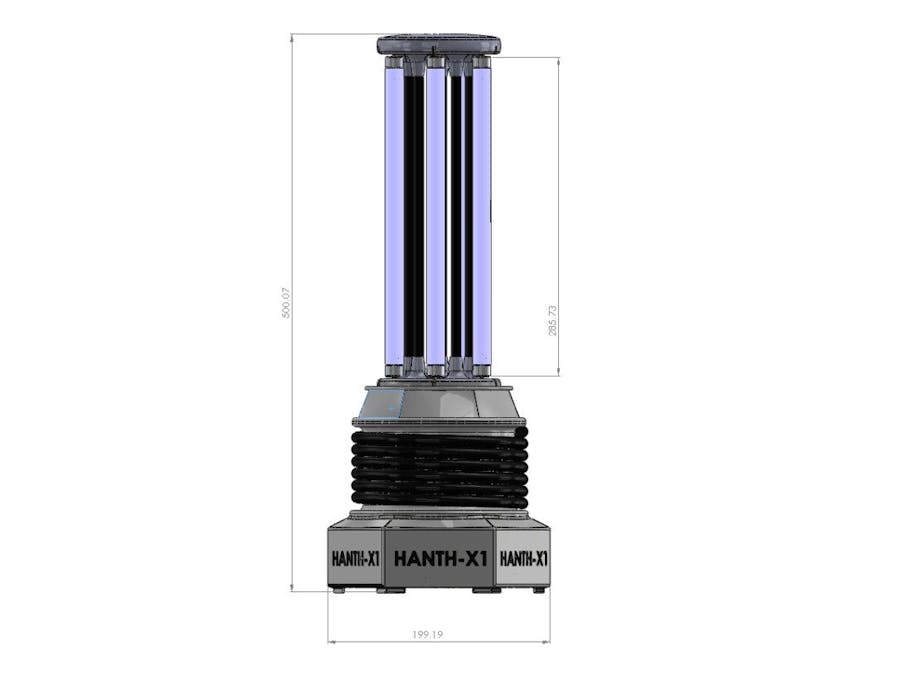To start with let me tell you that we human beings are blessed with technology so far discovered or invented and we need to adopt it for good. Like every bright side has a dark same in the case of technology also. I don't want to do a debate here but make a point. I am here to describe the good side of technology.
What we are seeing in the picture is my first prototype in the paper which is capable of doing disinfection of an area. Well well! you will say. what this new of it, this kind of things are there in the market and everyone knows about it. Yes, you are certainly right, but how many of you able to build it or possess the knowledge of this kind of devices. So here I am doing exactly the same spreading the knowledge as I grow my knowledge at the same time.
So lets Start:
This device main working principle is Ultraviolet-C radiation. UVC rays have more energy than other types of UV rays. Fortunately, because of this, they react with ozone high in our atmosphere and don’t reach the ground, so they are not normally a risk factor for skin cancer. But UVC rays can also come from some man-made sources, such as arc welding torches, mercury lamps, and UV sanitizing bulbs used to kill bacteria and other germs (such as in water, air, food, or on surfaces).
Since the last years, mobiles systems based on UV-C radiation have been used for cleaning and disinfecting hospitals
UV-C radiation inactivates microorganisms causing DNA damage by producing cyclobutane pyrimidine dimers (CPDs), altering DNA structure, and thus interfering with DNA replication [5], [6]. According to the World Health Organization Global Solar UV Index, the UV region covers the wavelength range from 100 to 400 nm and is divided into three bands: UV-A (315–400 nm) UV-B (280–315 nm) and UV-C (100–280 nm).
other methods of disinfection for large areas include the use of gaseous agents (formaldehyde, ethylene oxide, etc.) which are hazardous and require an airflow pattern. Likewise, liquid agents, such as sodium hypochlorite are also employed for disinfection purposes, but these must be carefully removed after being applied and may damage exposed materials (for example, electronic devices). Other methods include the use of ionizing radiation, but in addition to being hazardous, they require very specialized equipment. Although since the mid-20th century UV treatments have been used for disinfection, only in recent years this technology became more reliable as a consequence of the incremented lifespan of UV lamps. the use of UV-C is a chemical-free and low-cost procedure, which represents a green alternative method for disinfection.
Well! next is how this device works and what are the safety measures have been taken care.
- Hanth-x1 is the first model of its kind designed such a way to maintain the structural integrity with durable material.
- Total Autonomous and its never turned on if detect any leaving body.
- Operation cycle can be programmed remotely and also capable of video streaming.
- Install the app “UVC disinfection device” in your android mobile device. Previously, the Android device has to be enabled to install apps from unknown sources. Plug the UVC disinfecting device to the electrical network. The green LED will turn on
- Execute the app previously installed on your mobile device.
- Connect to the UVC disinfecting device by Bluetooth. Once the connection is established, the blue LED will turn on.
- Select the radiation time, you can manually set the time or choose it from the drop menu.
- Click on the “Activate” button. The app shows the estate of the UVC device as “Activated”. The red LED will turn on and start blinking. This light will be accompanied by the sound of the buzzer emitting several short beeps. After the last longer beep, the UVC lamps will turn on. The red LED will switch from blinking to continuous and will stay on as long as the UVC lamps are functioning.
- Click on the “Activate” button. The app shows the estate of the UVC device as “Activated”. The red LED will turn on and start blinking. This light will be accompanied by the sound of the buzzer emitting several short beeps. After the last longer beep, the UVC lamps will turn on. The red LED will switch from blinking to continuous and will stay on as long as the UVC lamps are functioning.
- The app will switch off the device upon completion of the programmed time. The app will show the estate of the device as “Inactivated” and the red light will turn off. Alternatively, the device may be switched off by clicking on the “stop” button. The timer may be reset by clicking on the “reset” button.
- The dosage reference table shows some reference values for UVC dosage required to disinfect up to 99.9% of different kind of microorganisms.
- Exit the app by clicking on the “Exit” button. The blue LED will turn off.
The main use of this sanitizer is to reduce or eliminate a wide range of microorganisms existing in a specific area. The reference values for dosage are provided to allow the user estimation of the minimum exposure time that needs to be used. These values are only indicative, and therefore, the optimal exposure time should be determined experimentally according to the needs. The dosages values indicated in reference can be used to estimate the required exposure time according to the following simplified method:
The UV-C dosage received by surface unit (D, expressed in J/cm2) at a given distance (r) from the sanitizer, depends on the power of the emitted UV-C light (P, equal to 8 W for our device) according to this equation:
(1)
D=(P.t)/(2π.L.r)
where L is the length of the UV-C lamps (30 cm) and t is the exposure time expressed in seconds.
Based on this equation, the exposure time can be calculated as follows:
(2)
t=(2π.L.r.D)/P
Using this method, a tool to estimate the minimum exposure time to reach the desired dosage for a certain distance from the device (Fig. 5b) was developed and is available in the initial screen of the app controlling the device.Hope you find this exciting. In case of this interests you, keep watching this space for more details
Designing PhasesThank you.
Note: Please contact me If we need more information.ReferencesD.J. Weber, H. Kanamori, W.A. Rutala
‘No touch’ technologies for environmental decontamination: focus on ultraviolet devices and hydrogen peroxide systems
Curr. Opin. Infect. Dis., 29 (4) (2016), pp. 424-431
View Record in ScopusGoogle Scholar
[2]
N. Mahida, N. Vaughan, T. Boswell
First UK evaluation of an automated ultraviolet-C room decontamination device (Tru-D™)
J. Hosp. Infect., 84 (4) (2013), pp. 332-335
ArticleDownload PDFView Record in ScopusGoogle Scholar
[3]
A. Beal, N. Mahida, K. Staniforth, N. Vaughan, M. Clarke, T. Boswell
First UK trial of Xenex PX-UV, an automated ultraviolet room decontamination device in a clinical haematology and bone marrow transplantation unit
J. Hospital Infect., 93 (2) (2016), pp. 164-168
ArticleDownload PDFView Record in ScopusGoogle Scholar
[4]
M.M. Nerandzic, J.L. Cadnum, M.J. Pultz, C.J. Donskey
Evaluation of an automated ultraviolet radiation device for decontamination of Clostridium difficile and other healthcare-associated pathogens in hospital rooms
BMC Infect. Dis., 10 (1) (2010)
Google Scholar
[5]
J.C. Chang, et al.
UV inactivation of pathogenic and indicator microorganisms
Appl. Environ. Microbiol., 49 (6) (1985), pp. 1361-1365
CrossRefView Record in ScopusGoogle Scholar
[6]
T.A. Conner-Kerr, P.K. Sullivan, J. Gaillard, M.E. Franklin, R.M. Jones
The effects of ultraviolet radiation on antibiotic-resistant bacteria in vitro
Ostomy Wound Manage., 44 (10) (1998), pp. 50-56
View Record in ScopusGoogle Scholar
[7]
S.I. Ahmad (Ed.), Ultraviolet Light in Human Health, Diseases and Environment, vol. 996, Springer International Publishing, Cham (2017)
[8]
A. Downes, T.P. Blunt
On the influence of light upon protoplasm
Proc. R. Soc. London, 28 (190–195) (1878), pp. 199-212
View Record in ScopusGoogle Scholar
[9]
P. Gøtzsche
Niels Finsen’s treatment for lupus vulgaris
J. R. Soc. Med., 104 (1) (Jan. 2011), pp. 41-42
CrossRefView Record in ScopusGoogle Scholar
[10]
E.A. Nardell, et al.
Safety of upper-room ultraviolet germicidal air disinfection for room occupants: results from the tuberculosis ultraviolet shelter study
Public Health Rep., 123 (1) (2008), pp. 52-60
CrossRefView Record in ScopusGoogle Scholar
[11]
R.M. Ryan, G.E. Wilding, R.J. Wynn, R.C. Welliver, B.A. Holm, C.L. Leach
Effect of enhanced ultraviolet germicidal irradiation in the heating ventilation and air conditioning system on ventilator-associated pneumonia in a neonatal intensive care unit
J. Perinatol., 31 (9) (2011), pp. 607-614
CrossRefView Record in ScopusGoogle Scholar
[12]
G. Messina, S. Burgassi, D. Messina, V. Montagnani, G. Cevenini
A new UV-LED device for automatic disinfection of stethoscope membranes
Am. J. Infect. Control, 43 (10) (2015), pp. e61-e66
ArticleDownload PDFView Record in ScopusGoogle Scholar
[13]
M.U. Owens, D.R. Deal, M.O. Shoemaker, G.B. Knudson, E. Janet, J.L. Deal
High-dose ultraviolet C light inactivates spores of Bacillus subtilis var. niger and Bacillus anthracis sterne on non-reflective surfaces
Area, 10 (November) (2005), pp. 1-6
CrossRefGoogle Scholar
[14]
R.L. Riley, E.A. Nardell
Clearing the air: the theory and application of ultraviolet air disinfection
Am. Rev. Respiratory Dis., 139 (5) (1989), pp. 1286-1294
CrossRefView Record in ScopusGoogle Scholar
[15]
Arduino, https://www.arduino.cc.
Google Scholar
[16]
J.M. Pearce
Chapter 1 – Introduction to open-source hardware for science
Open-Source Lab, Elsevier, Boston (2014), pp. 1-11
ArticleDownload PDFView Record in ScopusGoogle Scholar
[17]
MIT App Inventor 2, http://ai2.appinventor.mit.edu/.
Google Scholar
[18]
“Light Sources Inc and American Ultraviolet Company. UV irradiation dosage table.” [Online]. Available: http://www.americanairandwater.com/uv-facts/uvdosage.htm.
Google Scholar
[19]
“ClorDISys Company. UV irradiation dosage table.” [Online]. Available: http://www.clordisys.com/pdfs/misc/UV Data Sheet.pdf.
Google Scholar
[20]
K.C. Dhankani, J.M. Pearce
Open source laboratory sample rotator mixer and shaker
HardwareX, 1 (2017), pp. 1-12
ArticleDownload PDFView Record in ScopusGoogle Scholar
[21]
“UV-C lamps, Phillips TUV-T8 special lamps family.” [Online]. Available: http://www.lighting.philips.com/main/prof/conventional-lamps-and-tubes/special-lamps/purificationwater-and-air/commercial-and-professional-air/tuv-t8.
Google Scholar
[22]
Teamviewer, https://www.teamviewer.com/.Google Scholar
Follow
# IOT #COVID19
0 comments
Sign in to leave your comment




_ztBMuBhMHo.jpg?auto=compress%2Cformat&w=48&h=48&fit=fill&bg=ffffff)





Comments
Please log in or sign up to comment.